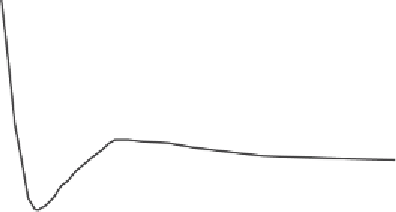Environmental Engineering Reference
In-Depth Information
S
ω
dB
90
80
70
60
50
40
8
ω
ω
p
1
2
3
4
5
6
7
Figure 3.24. Power spectrum of the time series shown in Fig.
3.23
(b). The black line
indicates the smooth background.
forcing in a way that this noise-induced threshold crossing has a typical time scale
.
A suitable synchronization with weak periodic forcing can then activate stochastic
resonance.
An interesting example of stochastic resonance emerging in systems that are not
bistable can be found in excitable systems. Their dynamics are characterized by peri-
ods of time at the “ground” (or “rest”) state randomly interrupted by quite impulsive
noise-induced excitation events that occur when a certain threshold is crossed. There-
fore excitable systems have only one stable state (the ground state) and one unstable
state (the so-called “excited” or “firing” state) from which the system decays after a
large excursion in the phase space. Remarkable examples of excitable systems include
chemical reactions, lasers, ion channels, and neuronal systems. In all these fields the
concept of stochastic resonance has opened new avenues for the interpretation and
the control of the relevant dynamics (
Lindner et al.
,
2004
).
t
c
SNR
d
( )
35
30
25
20
15
10
0.3
s
gn
0.1
0.2
Figure 3.25. Behavior of the SNR as a function of the noise intensity
s
gn
for model
(
3.64
).





























Search WWH ::

Custom Search